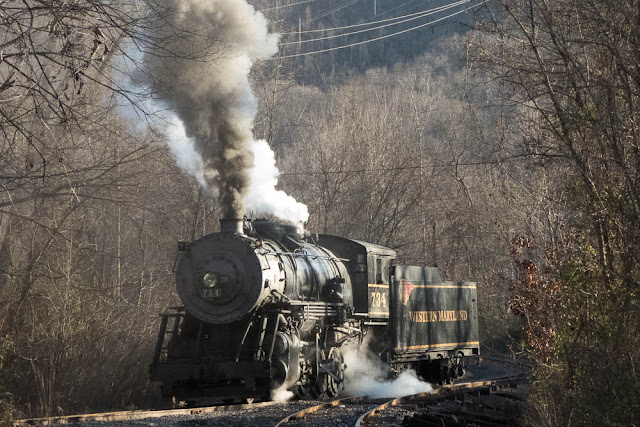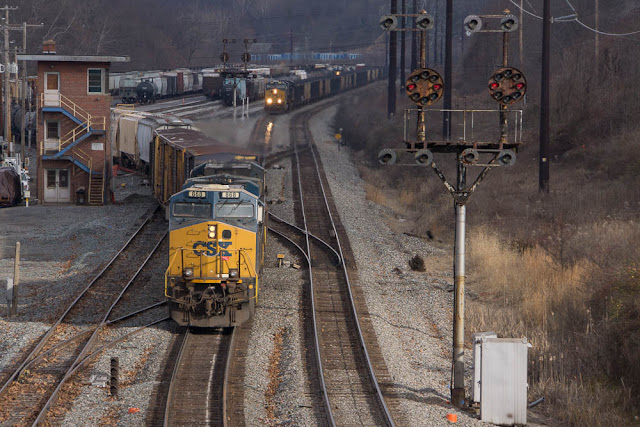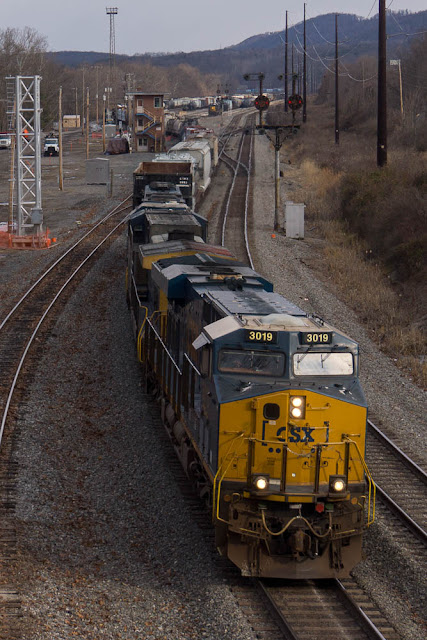 |
| Recently arrived from Shapeways: this 3D printed N scale Pennsy catenary bridge. The designer is arqtectdesigner, and he has a variety of N and HO Pennsy items on offer at his store on on the Shapeways site. The bridge is very crisply detailed and the material appears sturdy and flexible, with mounting holes in the footings for a strong mechanical attachment to the right-of-way. |
Model railroadin' and trains. . . the South Shore line, mostly, but anything electric or Northeast Corridor or Northwest Indiana turns up here
Sunday, March 27, 2016
3D Printed N Scale Penny Catenary Bridge
Saturday, March 19, 2016
A Comedy Writer at The Onion Knows Trains
 |
| Courtesy of theonion.com |
Sunday, March 13, 2016
Things You Can't (and Can) See in N Scale
| Steering clear of the trains: fenceless cattle avoiding the Santa Fe main line on Jim Kelly's N scale Tehachapi Layout Photo: Jim Kelly | Model Railroader | http://mrr.trains.com/ |
Jim started off discussing how fences and the like aren't visible from a distance, so he doesn't model fences. Later, he went off on a bit of a tangent regarding not modeling things he doesn't like, like rutty temporary access roads.
Re-reading this article and looking at the accompanying picture from Jim's inspirational Tehachapi layout, I realize that I agree with Dr. Jim's diagnosis but not his treatment. Regarding fences in specific, I don't think omitting them completely is as effective as modeling the parts of the fence you actually can see from a distance--such as the fence posts.
How to meet the challenge of interpreting and representing small or gossamer details is one of the differentiating features of excellent N scale and indeed all small scale modeling. Closely related to the artistry of fine detail in small scale is the artistry of color in small scale-- gloss and highlights, and colors generally, should be muted on smaller models. In short, N scalers can't just reproduce detail rivet for rivet or match a color chip--they have to get good at suggesting detail, and portraying color as if from a distance.
To really see the mastery of such tiny detail and subtle coloration, just Google 'best 1/700 naval models'. Here are models some four or more times smaller in scale than N scale trains. The really outstanding 1/700 ship models are masterfully painted and weathered, and have just enough detail added to make the viewer fill in the blanks of what is actually invisible from thousands of feet or even miles away.
As I plan my Old Line Corridor N scale layout, I have given thought to a particularly gossamer but pervasive detail around the Northeast Corridor and electrified Pennsy lines: catenary. Lately I've been looking at every electrified railroad picture that comes my way and asking, 'Can I see the wire?' And the answer is, 'it depends'. Depends on the angle, distance, lighting. Sometimes in close-ups it's there as if scrawled onto the photo with a Sharpie, but a lot of time the wire is wisps or traces. Other times, it's a crazy miasma of lines, arcs, and planes (the geometric kind) over the tracks.
The better question is, 'What do I see that makes this an electric railroad?' Poles and cross bridges are the obvious answer, but one detail that's sticks out is insulators, which often are the visual queue or hint that there's a wire running this way or that. And when wire is visible from a distance, it's not a lone wire, but a tangle, or it's not the contact wire but some other kind of transmission or guy wire.
I've noted previously that 'fake' catenary is a thing worthy of consideration, particularly in smaller scales or for photography. My next step is to experiment with the accoutrements of fake catenary--I'm accumulating a small collection of poles, bridges, string, wire for a fake catenary experiment. Check back in a few weeks to see the results.
Wednesday, March 9, 2016
Trains I See, Vidalia, Georgia Edition

Back on a rainy afternoon in October or so, this Georgia Central freight went by the hotel at which I was staying in Vidalia, Georgia. The 'Off the Beaten Track Branchline Railroading' group on Facebook was helpful in figuring what this is.
Sunday, March 6, 2016
The Old Line Corridor Horsetrade
 |
| Fussy pans that made my catenary building better |
 |
| That vestigial micro pan worked like buttah! |
 |
| Excellent runner and captain of the catenary testing team |
 |
| This guy was a growler |
 |
| An unsung hero of a model: excellent runner done right, but apparently Bachmann couldn't give 'em away. |
So I put all of my HO NEC gear up on eBay. I also liquidated my collection of unbuilt rare Star Wars kits also destined for closet glory. The result was a tidy PayPal nut that covered not only new a N scale Pennsy/NEC fleet but also a supply of Peco code 55 track and turnouts.
showed up here once. I mentioned Kato's ACS-64 here in a recent post, but is currently only available in a set with some beautifully done Amfleet I passenger cars. I'm already looking forward to seeing this locomotive offered with new road numbers and in the special new Veterans paint scheme. Bachmann's HHP-7s and Acela round out the modern fleet--they look great but require some tinkering to get running smoothly. The 'Hippos' came with DCC, and decoder installations for the Kato gear were easy with Digitrax drop-in decoders.
Tinkering with these models--installing DCC, couplers, and the like--was intimidating at first, but it didn't take long to get accustomed to the smallness, nay, the tininess of it all. The power and appeal of these models really came across during test runs and programming. I am now looking forward to building the layout on which to run these models.
Wednesday, March 2, 2016
Railfanning Cumberland, Maryland
 |
| In mid December, my photographer and beer connoisseur friend Mike Collins and I railfanned the Cumberland and Frostburg, Maryland area. The highlight of the trip was the Western Maryland Scenic Railroad's 2-8-0 #734. Here it is arriving at Frostburg on a cold clear day. |
 |
| 735 turning on the wye outside of Cumberland. |
 |
| The engineer oiling his magnificent machine. |
 |
| Steam on the road. |
 |
| Mike and I also spent some time at the Cumberland yard location known as 'Mexico'. No idea why it's called that, but the light and the action was interesting. |
 |
| Another departure from Mexico. |
Subscribe to:
Posts (Atom)
